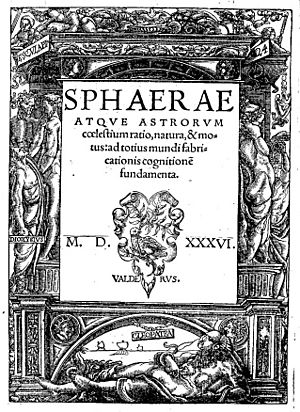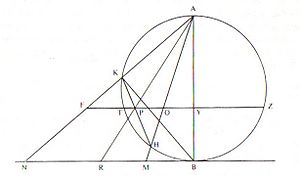Jordanus de Nemore facts for kids
Jordanus de Nemore (who lived in the 1200s) was a very important mathematician and scientist in Europe. His name, Jordanus de Nemore, suggests he might have been Italian. He wrote books on at least six different math topics. These included the study of weights, practical arithmetic, pure arithmetic, algebra, geometry, and stereographic projection. Many of his books have different versions from the Middle Ages. We don't know much about his personal life, only when he lived and worked.
Contents
Life
We don't know many details about Jordanus de Nemore's life. In old writings, he was simply called "Jordanus." Later, people added "de Nemore," which means "of the Forest." This doesn't give us any real information about him. During the Renaissance, his name was often written as "Jordanus Nemorarius," which was not quite right.
Some old records from the 1800s suggested Jordanus taught at the University of Toulouse. However, the text they referred to was not written by him, so this idea is probably wrong. A writer from the 1300s, Nicholas Trivet, thought Jordanus de Nemore might be the same person as Jordanus of Saxony. Jordanus of Saxony was a leader of the Dominican Order and taught theology. But this idea is also likely a mistake. Jordanus of Saxony was never known for math, and his name is not found on math books. Most experts today agree they were different people.
We believe Jordanus de Nemore worked in the early 1200s. This is because his books are listed in a book collection called the Biblionomia, which was put together between 1246 and 1260.
Writings
Jordanus de Nemore wrote many important books. They covered different areas of math and science.
Mechanics: The Science of Weights
The medieval "science of weights" is what we now call mechanics. This field became very important thanks to Jordanus's work. In his book Elementa super demonstrationem ponderum, he talked about "positional gravity." This is the idea that an object's weight can act differently depending on its position. He also used the idea of forces acting in different directions.
Jordanus showed how the law of the lever works using the idea of "work." He also figured out how unequal weights balance on slopes, long before Simon Stevin and Galileo did. His book Elementa super demonstrationem ponderum is definitely his work. It helped create a math basis for understanding the Roman balance.
Practical Arithmetic: Algorismi Treatises
Jordanus wrote five books about practical arithmetic. These books helped people learn how to do calculations.
His book Communis et consuetus seems to be the earliest version of his work on practical math. It is very similar to a longer book called Demonstratio de algorismo. Experts believe Communis et consuetus was definitely written by Jordanus.
The Demonstratio de algorismo has 21 definitions and 34 math problems. It is probably a later, expanded version of the Communis et consuetus. Jordanus himself or another mathematician from the 1200s might have made this version.
He also wrote books about fractions. The Tractatus minutiarum is about fractions and is often found with Communis et consuetus. The Demonstratio de minutiius is linked to the Demonstratio de algorismo and expands on the fraction problems.
Another book, Algorismus demonstratus, was thought to be by Jordanus for a long time. However, it was probably not written by him. It was the only one of his math books that was printed early on.
Pure Arithmetic: De elementis arismetice artis
This book on arithmetic has over 400 math problems. It is divided into ten parts. There are three different versions of this book. Jordanus wanted to write a complete summary of arithmetic, much like Euclid did for geometry.
Jordanus collected and organized everything known about arithmetic. He based his work on Euclid's books and on the writings of Boethius. He used definitions, basic rules, and then showed how to solve problems. He also used letters to stand for numbers, which was a new idea.
Algebra: De numeris datis
This book on algebra is very important. It has either 95 or 113 math problems, depending on the version. Some problems even have different ways of solving them.
Jordanus’s De numeris datis was the first advanced algebra book written in Western Europe. It built on ideas translated from Arabic math books. It was written 350 years before François Viète introduced similar ideas into Renaissance mathematics. Jordanus used a system where he set up a problem with what was known and what needed to be found. Then he showed how to change the problem to find the solution.
Geometry: Liber philotegni and De triangulis
This is a great example of medieval geometry. It has problems about the sizes of sides and angles in triangles. It also covers how to divide lines, triangles, and squares. Other topics include how arcs and flat shapes relate in circles, how to divide an angle into three equal parts, and how to find the area of triangles.
There are two versions of this text. The shorter one is called Liber philotegni Iordani de Nemore. The longer one, Liber de triangulis Iordani, divides the text into chapters and adds more problems. The longer version might not be by Jordanus, but it was definitely finished by the end of the 1200s.
Stereographic Projection: Demonstratio de plana spera
This book has five problems about stereographic projection. This is a way to draw a 3D sphere on a flat surface. It was used to make astrolabes, which were old tools for telling time and finding stars. The most important problem in the book shows that circles on a sphere always stay circles when projected onto a flat surface. People knew this was true before Jordanus, but he was the first to prove it.
There are three versions of this book. The basic text, a second version with an introduction and more details, and a third, slightly longer version.
Other Works
Some other books are sometimes said to be by Jordanus, but it's not certain. These include books on ratios (De proportionibus) and shapes with equal perimeters (Isoperimetra). Other books, like Liber de speculis, are definitely not by him.
Historical Fiction
The book "Eresia Pura" by Adriano Petta is a fictional story in Italian. It is based on historical research about the life of Jordanus de Nemore.
Editions of Jordanus’ Works
Most of Jordanus's works have been published in modern editions during the 1900s. This means that scholars have carefully put together the best versions of his original texts.
- His books on mechanics were published in a book called The Medieval Science of Weights in 1952.
- His practical arithmetic books were published in a math journal in the early 1900s.
- His pure arithmetic book, De elementis arithmetice artis, was published in 1991.
- His algebra book, De numeris datis, was published in a critical edition in 1981.
- His geometry books were published in a collection called Archimedes in the Middle Ages in 1984.
- His book on stereographic projection, Demonstratio de plana spera, was published in 1978.
See also
 In Spanish: Jordanus Nemorarius para niños
In Spanish: Jordanus Nemorarius para niños




